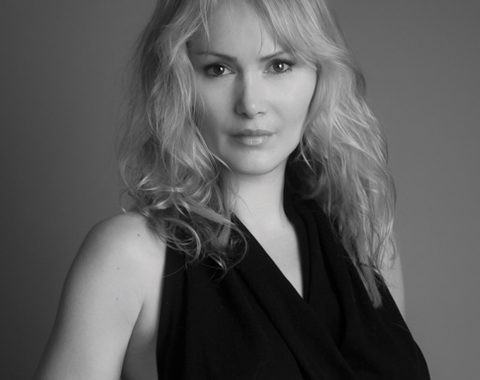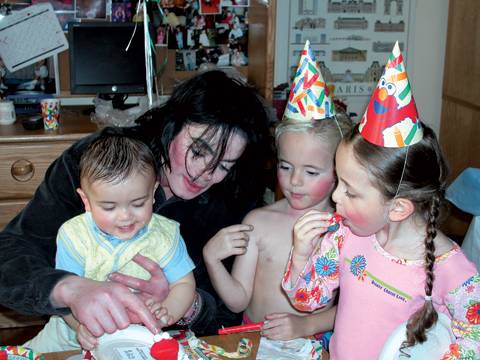By Twink Caplan
When there is someone in front of my camera who is very insecure I see how important it is to be sure of oneself.
A photograph is a miracle. It is the living past captured forever, of scenes vanished and people long dead, springing out with a flawlessly truthful image frozen in time. Tatijana Shoan’s cover portrait of Michael Jackson is such an image, capturing the soft and delicate person within and the sweet elusive smile that only becomes apparent by looking into his eyes. It is the suspended transitional portrait of a man in the latter stages of transformation.
Shoan was discovered as a model in high school and became the cover girl for the Harlequin Romance novels. Turning down a modeling contract in Argentina, she opted instead to study classical theater in London, England. After receiving her degree, she moved to New York City where she performed in several theater productions. However, it was landing the now infamous makeover gig for Monica Lewinsky that drew her into the spotlight as a makeup artist. This experience, and the many that followed, gradually steered her course away from the stage and back to the camera, only this time it was behind the lens. Shoan began working with distinguished photographers like Timothy Greenfield-Sanders, Annie Leibovitz, Henri Cartier-Bresson, Michel Comte, and the late Richard Avedon. It was working with these masters that inspired Shoan to take her passion for photography and turn it from a hobby into a career.
Inside her studio, I am immediately taken by the high ceilings, marble floors, and vintage European posters, but most impressive is the artwork by Gilbert and George, Ronnie Cutrone, and Helmut Newton. Tatijana emerges with two rose petal teas in Moroccan glass cups. She is a tall blonde who laughs at all my jokes, so naturally I love her right away. In fact, I’ve known her for more than a decade and witnessed her evolution. Her photographs are enticing, intelligent, and at times controversial. I sat down with my long-time friend for this exclusive interview for Haute Living Los Angeles.
TWINK CAPLAN How did this extraordinary opportunity to photograph Michael Jackson come about?
TATIJANA SHOAN I seized the moment. I was living at Robert Evans’ house at the time and the interesting thing about his home was that you never knew who was going to be there. This particular night, amongst the guests was Michael Jackson. I’ve been a fan of his since grade school. Every Sunday my favorite show would air a Michael Jackson video. My mother and I would watch it religiously and practice all his moves. Then the neighbors started coming over and it became a regular thing. When I met him, he was sitting on the sofa, just observing the crowd. He didn’t have a slew of people surrounding him. As I approached him, he smiled so sweetly and said, “Hi, I’m Michael,” in a soft, Disney-like whisper. I told him what a huge fan I was and how his music and dancing shaped my upbringing. “Thank you, thank you so much,” he chimed. I said I would be honored if he would allow me to take his photograph and he demurely said, “Of course.”
TC That was very generous of him. Did you move into the light or direct him in any way?
TS No. I wanted to capture what was in front of me and not recreate something that wasn’t there. Meeting him was like seeing a unicorn because over the years he’s become a fairytale legend, something that’s based in fantasy.
TC What have you learned about life through the faces of the people you photograph?
TS Oh, that’s a good question. I think my biggest lesson has been to accept myself, which sounds cliché. I admit my eye is drawn to physical beauty for the sheer rarity of it, but when there is a subject in front of my camera who is comfortable in their skin, their soul comes through and that is not something fake or fleeting. Does that make sense? I have also learned that self-consciousness is not attractive. When there is someone in front of my camera who is very insecure I see how important it is to be sure of oneself.
TC I think a conventional looking person who exudes the freedom that comes from confidence is open and becomes beautiful.
TS Absolutely. More importantly, they are compelling.
TC Michael Jackson was endearingly vulnerable in life, yet on stage he radiated confidence. Did you feel he was self-conscious when you photographed him?
TS Actually, no he wasn’t. He was meek, he was kind and fragile and yet the biggest superstar in the world! He’s a dichotomy; he’s like no one else.
TC I agree. How do you make your subjects feel comfortable?
TS To be honest, I don’t try to make them feel comfortable. I try to feel the energy between us and work the light and camera around that. I don’t want moments to be contrived. Somehow in just allowing the natural energy to happen they end up feeling comfortable.
TC When you shoot people of great accomplishment, are they different from others in their demeanor or comfort zone?
TS For the most part I’ve noticed my subjects of stature exude strength and confidence and it’s no surprise that they are where they are. Though the photo of Michael Jackson, for instance, I think is very vulnerable. It depends on the person, not their station in life.
TC How do you see the difference between fashion and portraiture, and what are the challenges with both?
TS I love fashion because the creativity is endless, but it’s very important to create a beautiful silhouette. For me, fashion is about shape and form and how to creatively express that. When I’m taking a portrait, my focus must be on who they are and why they are. I can’t have my imagination draw attention away from my subject; it must illuminate aspects of them. There are challenges to both. I studied portraiture with one of the greatest living portrait photographers, Timothy Greenfield-Sanders, whose work hangs in museums around the world. I watched how he would interact with his subjects, how he angles the light and camera, and how he would wait for the exact moment when the muscles in their face would relax. He would engage them at all times.
TC I adore the portrait you did of Timothy! He simply owned the photo and was master of his domain. He looks so at ease.
TS I gave him a Xanax…just joking.
TC I think in every artistic endeavor one has to let go of control in order to find the greatness. What is it like for you to be the one in control behind the lens?
TS I go from being a participant to being a voyeur. When I’m being a voyeur I watch them through my camera and don’t say anything and they start to forget about me. It’s the moments when they are waiting for me that they leave themselves alone and I get truthful images. The times I’m being a participant I will interact with them and get spontaneous reactions, which are fresh.
TC Describe your chemistry with photography.
TS It’s probably the one reason I’m still single (laughs). It dominates 99 percent of my mind. I have hundreds of shoots in my head and I’m always searching for opportunities to express them. I haven’t left much room for anything else. So I’d say my relationship with photography is one of an obsessed lover.
More of Tatijana’s work can be viewed on her website: www.tatifoto.com





















